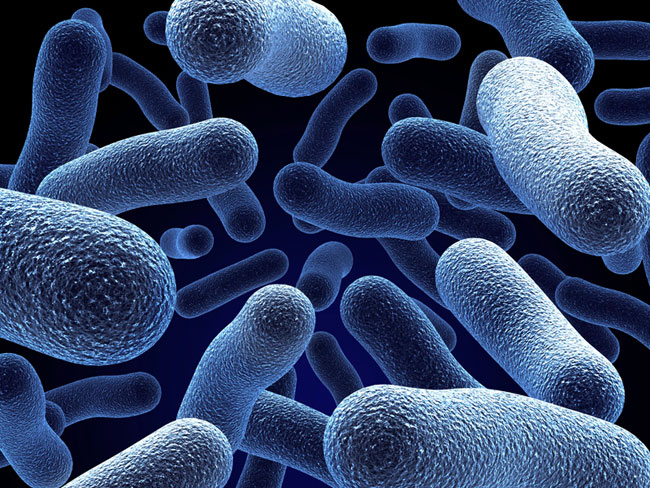
Communication is vital to any successful relationship. Researchers from the Institute of Food Research and the University of East Anglia have discovered how the beneficial bacteria in our guts communicate with our own cells.
This is a key step in understanding how our bodies maintain a close relationship with the population of gut bacteria that plays crucial roles in maintaining our health, fighting infection and digesting our food.
A study, published in the journal Cell Reports, shows that the gut bacteria produce an enzyme that modifies signalling in cells lining the gut. The enzyme also has another role in breaking down food components.
“Our study provides a breakthrough in understanding how bacteria communicate across different kingdoms to influence our own cells’ behavior, as well as how we digest our food,” said Dr Regis Stentz from the IFR, which is strategically funded by the Biotechnology and Biological Sciences Research Council.
We all rely on trillions of bacteria in our gut to break down certain components of our diet. One example is phytate, the form phosphorus takes in cereals and vegetables. Broken down phytate is a source of vital nutrients, but in its undigested form it has detrimental properties. It binds to important minerals preventing them being taken up by the body, causing conditions like anemia, especially in developing countries. Phytate also leads to excess phosphorus leaching into the soil from farm animal waste, and feed supplements are used to minimize this.
But despite the importance of phytate, we know very little about how it is broken down in our gut. To address this Dr Stentz and colleagues screened the genomes of hundreds of different species of gut bacteria. They found, in one of the most prominent gut bacteria species, an enzyme able to break down phytate. In collaboration with Norwich Research Park colleagues at the University of East Anglia, they crystallized this enzyme and solved its 3D structure. They then went on to characterize the enzyme, showing it was highly effective at processing phytate into the nutrients the body needs.
The bacteria package the enzyme in small ‘cages’, called outer membrane vesicles (OMVs) which allow phytate in for nutrient processing but prevent it being destroyed by our own protein-degrading enzymes. This releases nutrients, specifically phosphates and inositol, which can be absorbed by our own bodies, as well as the bacteria.
Working with Professor Stephen Shears, an expert in phosphate signalling from the US National Institutes of Health, the researchers showed that the OMVs containing the enzyme affect calcium signalling of colonic epithelial cells. Cells use calcium signalling to regulate different internal activities. This suggests that bacteria are using OMV-packaged enzymes to communicate directly with our cells and influence their behavior, an example of cross-kingdom communication. OMVs have been observed from pathogenic bacteria looking to invade host cells, but this is the first example that benefits both the host and the bacteria.
“The enzyme we’ve uncovered has dual roles, in providing dietary nutrients as well as in modifying host cell behavior,” said Professor Simon Carding who leads IFR’s research into gut health. “This opens up a number of very exciting areas of research.”
Uncovering how we breakdown phytate will improve our understanding of how we maintain health, and possibly provide new avenues to reducing its effects in exacerbating malnutrition.
The researchers are interested in seeing how well this new enzyme compares with current fungus-derived feed supplements in preventing the problem of excess phosphorus from farm animal waste.
Co-author Dr Charles Brearley, from UEA’s school of Biological Sciences, said: “The addition of enzymes, including phytases, to animal feed is a $725 million global industry. Industrial biotechnology, including the processes by which enzymes such as phytases are engineered, is a priority of the BBSRC.”
“Our ongoing research here at UEA looks at the 3D structure of this novel phytase and the detailed analysis of phytate degradation. We believe this will be of great value in helping develop tomorrow’s high value animal feed enzymes.”
The IFR team also want to investigate the role these bacterial enzymes play in cross-kingdom communication, to find out the consequences of the calcium signalling changes. The gut lining is highly dynamic, containing stem cells that give rise to a number of different cell types that help to maintain the gut in a healthy state. Gut bacteria play a role in maintaining this healthy state, with diversions from this implicated in a number of diseases. Knowing how bacteria communicate with us opens up new possibilities to investigate this further.
“This has been a great example of how the Norwich Research Park’s multidisciplinary research has cracked one of the big mysteries in gut health — how do beneficial bacteria communicate with human cells. ” commented IFR’s Professor Carding, who is also Professor of Mucosal Immunity at UEA. “We are attracting world leaders in this area to come and work with us, which is a real endorsement of our combined expertise.”